Exploring the Fascinating World of Snakes in Australia!
Welcome, young explorers, to an incredible adventure through Australia’s fascinating world of snakes! Get ready to unlock the secrets of these slithering creatures that call the land Down Under their home. From the smallest to the largest, the fastest to the stealthiest, snakes are nature’s incredible wonders waiting to be discovered!
In our thrilling quest to unravel the mysteries of snakes, we’ve compiled a special list just for you. Discover Australia’s most fascinating snake species and learn how to identify them. We’ll share awesome tips on where to spot these magnificent creatures up close and even introduce you to some reptile parks where you can witness the magic firsthand. So, get ready to become snake-savvy explorers and embark on an adventure!
Meet the Snakes of Australia: Venomous and Non-Venomous Species
Hey there! Did you know that Australia has loads of snakes? We’re talking about a whopping 140 different kinds on land and even 32 kinds in the sea! That’s more snakes than you can count on your fingers and toes!
But don’t worry, not all of them are super scary. Out of those 140, only around 100 are venomous, and guess what? Only 12 of them are really dangerous. Phew, that’s a relief, right?
Now, let’s meet the coolest guys in the snake world: the front-fanged group! They are the sneaky tigers, the speedy browns, the sly death adders, and the mighty mulgas or king browns. Oh, and let’s not forget their underwater buddies, the sea snakes, who love to make a splash!
And there’s another group called the rear-fanged snakes. They’re not as dangerous as the front-fanged ones, but they still have some tricks up their scaly sleeves. The brown tree snake and mangrove snakes are part of this cool crew. They might give you a little nip but don’t worry, it won’t be as scary as their front-fanged cousins.
But hey, not all snakes are out to get you. We’ve got some friendly ones too! Meet the solid-toothed non-venomous snakes. They’re like the superheroes of the snake gang, including the pythons, blind snakes, and file snakes. They may not have venom, but they’ve got plenty of charm!
So remember, snakes can be fascinating, but it’s always best to admire them from a safe distance.
Stay Snake Safe!
Always remember to be snake smart and safe. Always respect snakes and keep your distance. Snakes do not like to be approached. When walking around the bush, remember to stomp your feet to keep snakes away. Most snake bites happen when snakes are attacked or approached. Should you come across a snake on your property, contact a professional snake catcher (more below).
If you are bitten by a snake, contact emergency services immediately on 000. Seek medical assistance immediately for all bites.
Venomous or Harmless? How to Tell the Difference?
Have you ever wondered how to tell one snake from another? Well, prepare for a wild adventure because distinguishing snakes is all about the details, just like solving a cool puzzle! So put on your little detective hats and get ready to explore the enchanting universe of snakes. It’s time to discover the secret clues that make each snake unique and extraordinary.
You can think of venomous snakes as sneaky spies who have special powers. If you check out their heads: venomous ones have a triangle-shaped head, while non-venomous snakes have a round head, like a friendly buddy. It’s like telling spies from regular folks!
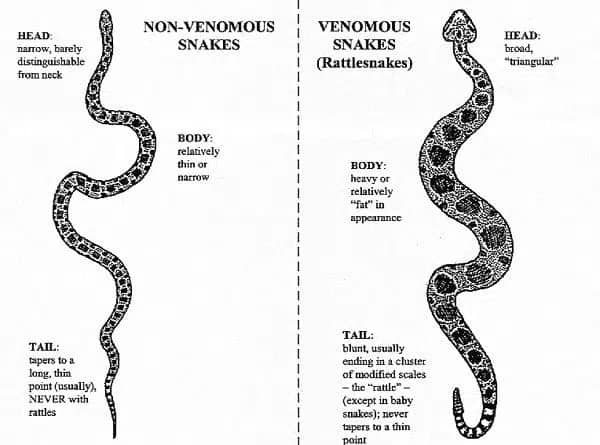
Now, let’s zoom in on their eyes. Venomous snakes have slitted pupils, like cool cat eyes that say, “Watch out, I mean business!” Non-venomous snakes? They have round pupils, like big, curious eyes, ready for adventure. It’s like spotting a superhero in disguise!
But wait, there’s more! Venomous snakes like secret spy sensors have tiny pits on their faces. They can detect even the tiniest temperature changes! Non-venomous snakes don’t have these fancy pits but make up for it with their other amazing senses.
Check out the tail! When these venomous snakes are agitated or ready to strike, they may hold their tails high and move them rapidly from side to side, almost like a striking whip. It’s a warning sign that they mean business and should be given plenty of space.It’s their way of saying, “Hey, I’m dangerous. Stay away!” Non-venomous snakes in Australia have a different way of using their tails. Rather than using their tails as a warning signal, non-venomous snakes typically use their tails for balance and movement. They may slither smoothly and gracefully, using their tails to navigate through their surroundings. Some non-venomous snakes might even use their tails to hold onto branches or objects while climbing trees. It’s fascinating to see how these snakes make use of their tails in unique ways that are different from their venomous counterparts. How clever is that?
And here’s a more colourful clue! Venomous snakes are like fashionistas, rocking bright colours and fancy patterns. They’re nature’s trendsetters! Non-venomous snakes prefer a simple look with solid colours. They’re all about that sleek and stylish vibe!
Remember, young adventurers, it’s all about the details! You’ll become a snake expert by spotting these awesome features in no time. So, when you’re out exploring and meet a slithery friend, you’ll know if they’re a venomous VIP or a friendly pal by just observing the details.
Australia’s Deadly Beauties: Venomous Snakes
Want to know more about the poisonous snakes in Australia? Hold onto your hats, young adventurers, because we’ve cracked the code on Australia’s top 10 venomous snakes! Get ready to meet the stars of the slithering world, each with their own unique features that have earned them a ferocious reputation. With this handy guide, you’ll become an expert in no time, able to identify these serpents from a mile away!
Eastern Brown Snake
Imagine this: you’re strolling through the Aussie outback, and out of nowhere, a speedy streak of brown slithers across your path. Whoa! It’s the Eastern brown snake, a.k.a. the common brown snake, ready to show off its impressive moves. These snakes are known for their lightning-fast speed and feisty personalities. They’re like the race cars of the snake world!
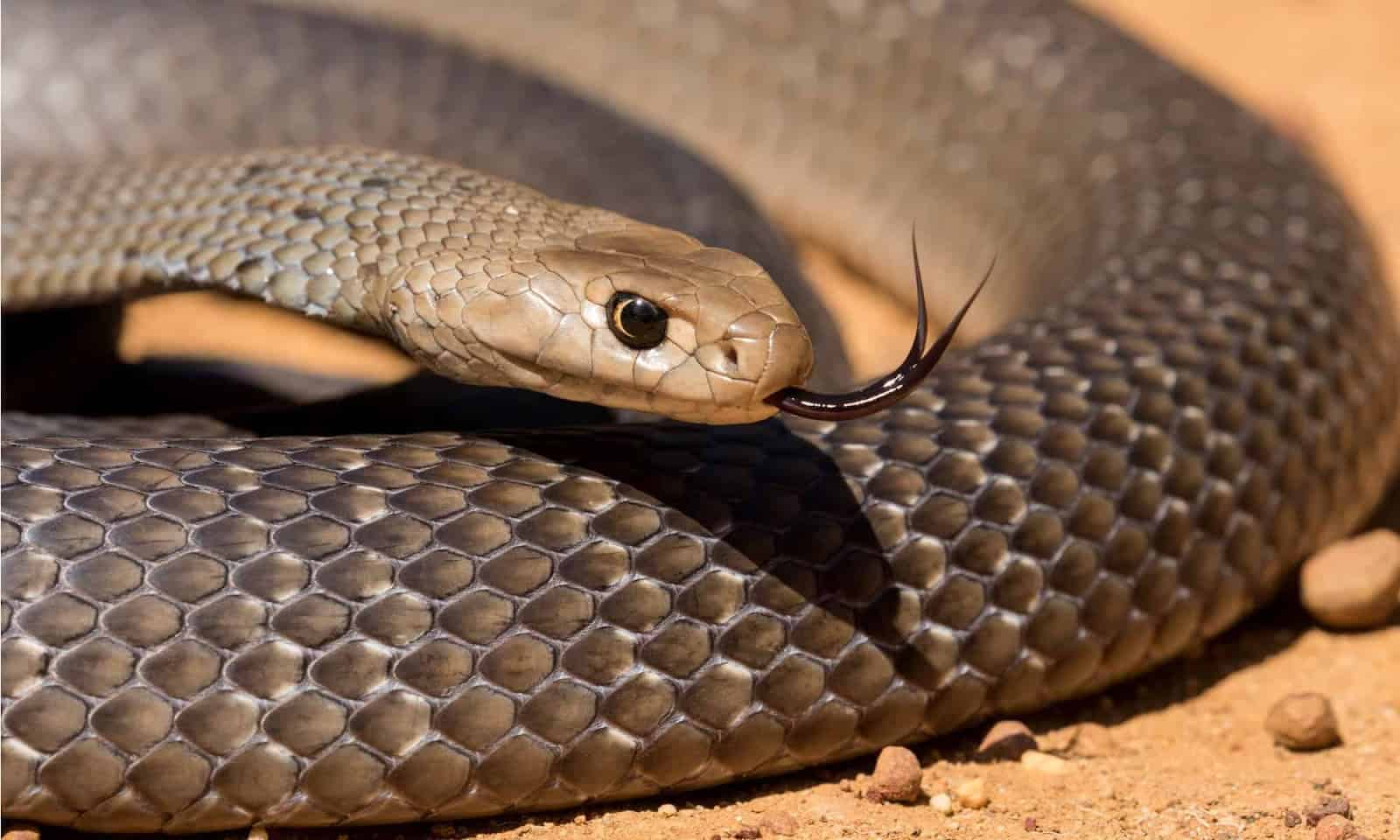
But here’s the real shocker: Eastern brown snakes hold a world record! They’re responsible for more snake-related mischief than any other snakes Down Under. Yep, they’re famous for their venom, which is ranked as the second most potent among land-dwelling serpents. It’s like they have a secret recipe for super-strong venom!
If you ever spot an Eastern brown snake, beware of its sassy attitude! When they feel threatened, they strike a pose, lifting their bodies off the ground in a sneaky “S” shape, jaws wide open. It’s their way of saying, “Don’t mess with me!” Their venom causes a unique kind of paralysis and makes blood refuse to clot. That’s some serious snake magic right there!
So, remember to give these brown beauties plenty of space and admire them from a safe distance. Let’s keep our senses sharp and learn all about these incredible creatures that roam our wild lands. Who knows? You might become the next snake whisperer.
Western Brown Snake
Welcome, young adventurers, to the wild and wonderful world of the Western Brown Snake, also known as the gwardar! Get ready to go on a thrilling journey across the vast lands of mainland Australia, where these slithering wonders can be found. Are you prepared for an expedition filled with thrilling facts? Let’s dive right in!
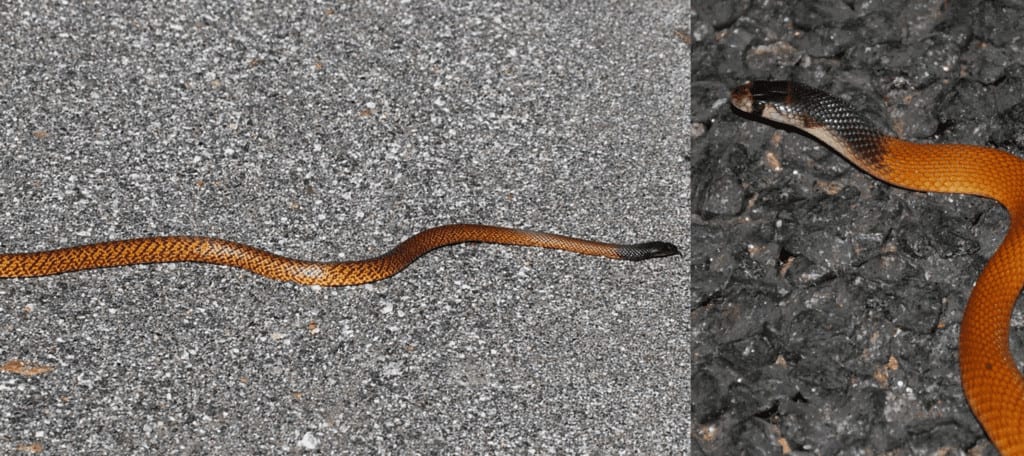
Imagine yourself in the heart of Australia, surrounded by sweeping landscapes and breathtaking vistas. The Western Brown Snake calls this place home, with its range stretching far and wide across most of the mainland. You won’t find them in the wetter parts of eastern Australia or the southwestern region of Western Australia, but they’re the cool snakes on the block everywhere else!
Now, here’s a little secret—the Western Brown Snake is said to be a bit less aggressive than its eastern cousin. However, don’t let that fool you, my adventurous friends! These snakes still command respect and caution. They are part of the snakes responsible for the most fatalities in Australia. So, it’s important to give them their space and observe them from a safe distance.
Western Browns are known for their speed and nervous temperament. When they feel disturbed, they won’t stick around for a chat. Oh no! They’ll make a lightning-fast dash for cover, using their quick reflexes to escape any sticky situations. But if you happen to corner one by accident, be prepared for a striking surprise before they make a quick getaway. It’s their way of saying, “Oops, I’m not too thrilled about this encounter!”
Now, let’s talk about venom—the superpower that makes these snakes both fascinating and potentially dangerous. While the venom of the Western Brown Snake is not as toxic as its eastern cousin’s, it delivers three times the amount! Talk about a venomous punch! Their bites are usually painless, and the tiny fang marks may be hard to spot. But don’t be fooled by their stealthy style—they pack a punch in their venomous payload!
When someone unfortunate encounters a Western Brown Snake, they might experience a headache, nausea, abdominal pain, and severe coagulopathy (that’s a fancy way of saying a blood clotting disorder). Sometimes, the venom can even cause kidney damage. That’s why it’s important to remember that these snakes are best appreciated from a safe distance, letting them go about their snakey business undisturbed.
As our adventure with the Western Brown Snake comes to a close, remember to always be respectful of these incredible creatures and their natural habitats. We humans have the amazing ability to observe, learn, and coexist harmoniously with the animals that share our world. By embracing curiosity, knowledge, and a touch of caution, we can ensure that the wonders of nature continue to thrive.
Mainland Tiger Snake
Did you know that Tiger Snakes are fascinating and have a unique sense of style? Let’s learn some interesting facts about these slithering creatures.
Tiger Snakes have bodies covered in bands that resemble a tiger’s skin. This distinctive pattern gives them their name and makes them easily recognizable. However, it’s very important to note that there are different variations, or “morphs,” of Tiger Snakes.
The Common morph displays olive, green, or brown shades with cream-coloured crossbands. The Western morph stands out with its dark blue or black body and yellow bands. Meanwhile, the Chappell Island morph can be black, brown, or olive, with lighter bands for effective camouflage.
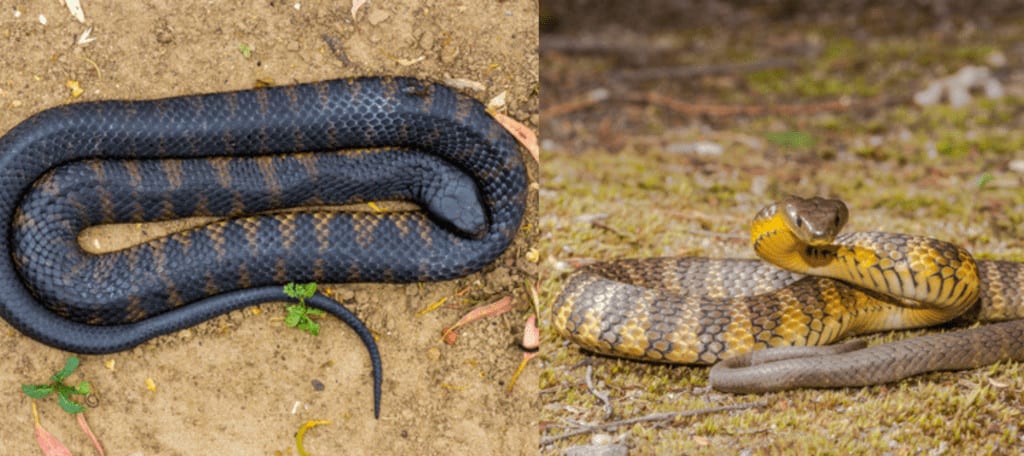
In addition, two variations are found in the King Island and Tasmanian morphs. Some individuals have deep black bodies with light crossbands, while others are uniformly brown without any banding. Lastly, the Southern Peninsula’s morph boasts a black body with a white chin and lips, creating a striking contrast.
When it comes to behaviour, Tiger Snakes are adaptable creatures. They enjoy basking in the sun or seeking shelter under fallen trees but are equally adept at swimming and climbing. Their versatile skills enable them to navigate various environments with ease.
While Tiger Snakes prefer to avoid confrontation, they can become aggressive if threatened. When cornered, they may lift and flatten their forebody as a warning before swiftly striking. It is essential to give these snakes their space and avoid provoking them.
Now, onto an important topic – the venom of Tiger Snakes. Their bites can be dangerous to humans, requiring immediate medical attention. Symptoms such as numbness, profuse sweating, or difficulty breathing may occur if bitten. Prompt treatment significantly increases the chances of survival.
So, remember to admire Tiger Snakes from a safe distance and appreciate their unique appearance and adaptive nature. These remarkable snakes serve as a reminder of the diverse wonders found in the animal kingdom.
Inland Taipan
Get ready to meet the reclusive and rare superstar of the snake world, the Inland Taipan! This extraordinary snake goes by a few cool names, like the Fierce Snake or the Small-Scaled Snake. Let’s learn some fascinating facts about this amazing creature!
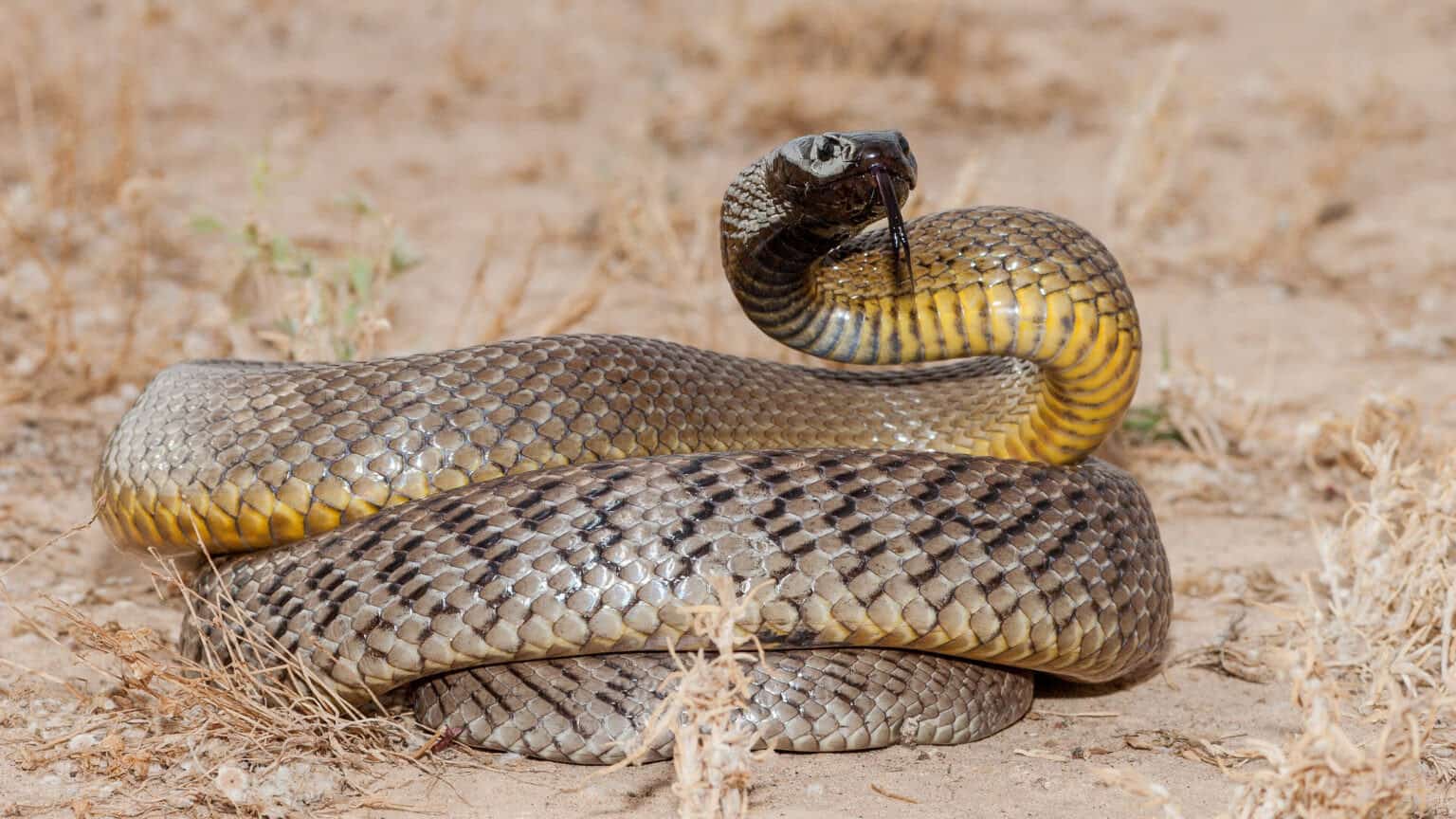
Now, the Inland Taipan is a true master of hide-and-seek. It loves to hang out in its secret hideaways amidst the dry, rocky plains where the borders of Queensland, South Australia, New South Wales, and the Northern Territory converge. It’s like having its own VIP spot in the snake world!
But here’s where things get really impressive. The Inland Taipan’s venom is no joke. In fact, it’s considered the most potent venom of any land snake in the entire world! This venom is so powerful that it has the potential to take down an adult human within a jaw-dropping 45 minutes. Talk about packing a punch!
When it’s hunting time, this super snake doesn’t mess around. It loves to explore the tight and cosy burrows of the long-haired rat, its favourite prey. And guess what? The Inland Taipan doesn’t hold back. With just one bite, it injects over 40,000 times the amount of venom needed to take down a 200g rat. That’s like saying, “No chance, little rat!”
Now, here’s the good news for us humans. Only a handful of people, and I mean a tiny handful, have been bitten by this snake. And guess what again? They all survived! Thanks to the quick first aid and hospitalisation, these brave snake handlers came out victorious. It’s a testament to the importance of safety and getting the right help when needed.
So, while the Inland Taipan may be an elusive and venomous legend, it reminds us of the incredible wonders that exist in the animal kingdom. Remember to admire it from a distance and appreciate its unique role in our wild world. Stay curious and keep exploring, my fearless friends!
Coastal Taipan
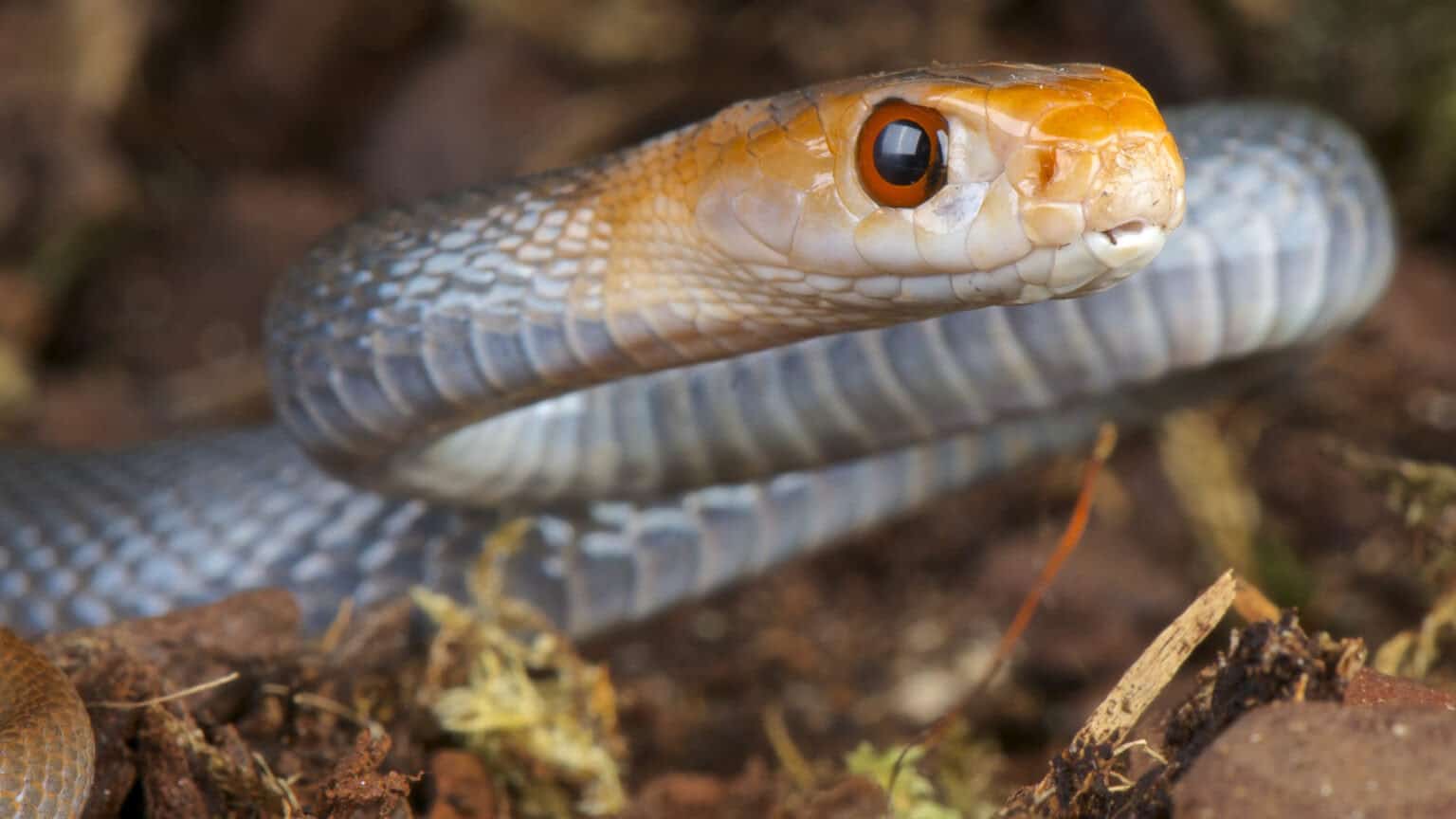
Get ready to explore the coastal regions of Australia and meet a snake with some serious fang power – the Coastal Taipan, also known as the Eastern Taipan! This slithery superstar loves to hang out in an arc along the east coast, from northern New South Wales all the way up to Brisbane and even parts of northern Western Australia. Oh, and they have a soft spot for sugarcane fields too!
Now, get ready to be amazed because the Coastal Taipan holds a pretty impressive record. It boasts the longest fangs of any snake in Australia, measuring a whopping 13mm! That’s like having tiny daggers in its mouth. But wait, there’s more! Its venom is considered the third most toxic of all land snakes. Talk about a venomous combo!
When it comes to their personality, Coastal Taipans are like ninja warriors. They’re extremely nervous and alert, always looking for surprises. And boy, do they put up a fierce defence if they feel cornered! They freeze momentarily, gathering all their energy, and then launch forward with lightning-fast strikes, snapping multiple bites in a flash. It’s like watching a snake in action movie mode! But here’s the secret – they’re not usually confrontational and would rather slither away from potential threats.
Now, here’s a piece of history for you. Back in the day, before the introduction of specialised antivenom in 1956, Taipan bites were quite serious. In fact, they were often fatal and caused many human deaths. The venom of these snakes wreaked havoc on the nervous system and blood, causing symptoms like nausea, convulsions, internal bleeding, muscle destruction, and kidney damage. It was definitely a tough battle. In severe cases, the unthinkable could happen in just 30 minutes. Thank goodness for antivenom and modern medicine!
So, my adventurous friends, while the Coastal Taipan may be a formidable snake, it serves as a reminder of nature’s incredible diversity and power. Admire them from a distance, respect their space, and appreciate the amazing wonders in our world. Stay curious and keep exploring, but always remember to stay safe!
Mulga Snake
Get ready to meet the heavyweight champ of venomous snakes in Australia, the incredible Mulga Snake, also known as the King Brown Snake! This slithering superstar has a fan club all over Australia, except for Victoria, Tasmania, and the southern parts of Western Australia. Talk about having a widespread following!
Now, get ready for a mind-boggling fact: the Mulga Snake not only has an impressive size but also delivers a venomous wallop like no other snake in the world! It holds the record for the largest venom output ever recorded! Imagine this, with just one bite, it unleashes a jaw-dropping 150mg of venom. That’s like a superhero power but with scales!
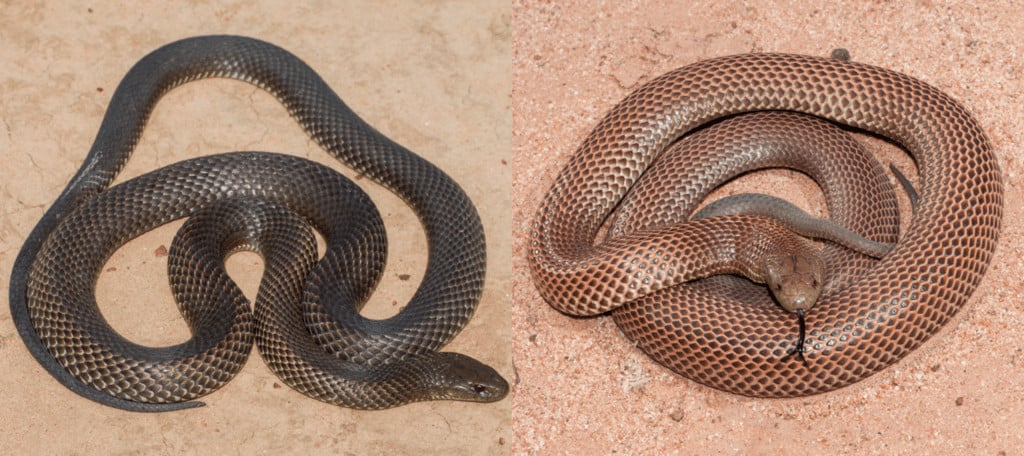
But wait, there’s more to this sensational snake! Their personalities can vary depending on where they’re from. The southern Mulgas are known to be shy and quiet, while their northern buddies can be a bit more feisty. They might start throwing their heads from side to side and hissing loudly when disturbed. It’s their way of saying, “Hey, back off, mate!”
Now, let’s talk about their biting skills. Brace yourself for this jaw-dropping detail: Mulgas don’t mess around when it comes to biting! They sink their teeth in and can even hang on and chew. It’s like they’re saying,”I’m feeling really defensive right now, so please respect my space and avoid any conflicts.” Their highly toxic venom can cause some serious mischief, affecting blood cells, muscles, and nerves. So, if you ever encounter one and get bitten, it’s essential to seek help ASAP and get treated with black snake antivenom. Safety first, my adventurous buddies!
So, next time you’re exploring the wilds of Australia, keep an eye out for the mighty Mulga Snake. Admire its heavyweight status and remember to give it the space and respect it deserves. These snakes are like nature’s incredible champions, reminding us of the awe-inspiring wonders that exist in the animal kingdom!
Lowlands Copperhead
Calling all young nature enthusiasts! Get ready to meet a fascinating snake known as the Lowlands Copperhead, also called the Copperhead Snake or the Common Copperhead. These slithery creatures have some incredible features, so let’s head on an exciting journey of discovery!
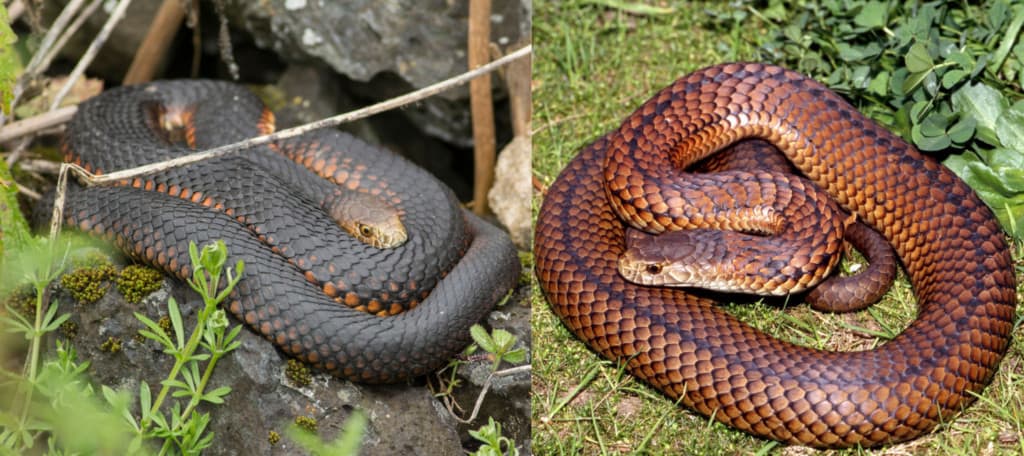
Imagine a snake that can grow as long as a tall basketball player, reaching lengths of 100 to 150 centimetres! The Lowlands Copperhead has a small, narrow head with unique raised scales. Their colours range from reddish-brown to shiny copper; some even sport shades of grey. They sure know how to stand out in the snake fashion show!
Now, if you explore Australia’s freshwater scrublands, swamps, or marshes, keep your eyes open for these amazing snakes. But here’s something intriguing – sometimes they venture into urban areas for a delicious meal. They’re like stealthy snake detectives on a culinary mission!
When it comes to dining, Lowlands Copperheads have a taste for frogs and lizards. Yum! But here’s the surprising part – these sneaky snakes sometimes engage in cannibalism. That means they might enjoy a snake snack! When they’re not hunting, they seek refuge in abandoned animal burrows. They’re like the clever architects of the snake world, creating cosy hideaways!
Now, brace yourselves for an exciting fact about the Lowlands Copperhead – they can handle colder temperatures like true champions. While other snakes prefer to take a winter nap, these copperheads stay active, slithering through the chilly weather. They’re like the adventurous explorers of the snake realm, defying the odds!
But here’s something important to know: Lowlands Copperheads are usually shy, but they can get feisty when feeling threatened. If you ever encounter one, they might hiss and thrash about to protect themselves. It’s their way of saying, “Hey, back off!” And here’s a crucial piece of information – their bites can cause loss of consciousness, convulsions, and even death. But don’t worry! There’s a special antivenom that can help. So if you ever have a close encounter, seek medical help right away.
So, my young explorers, the Lowlands Copperhead reminds us of the incredible wildlife that surrounds us. Admire these snakes from a safe distance, respect their homes, and always stay curious about the wonders of nature. Keep exploring, and remember to appreciate the incredible diversity of our planet’s creatures.
Small-eyed Snake
Meet the sneaky serpent known as the Small-eyed Snake, also called the Short-tailed Snake or the Eastern Small-eyed Snake. These slithery creatures might not have big, flashy eyes, but they have some remarkable qualities.
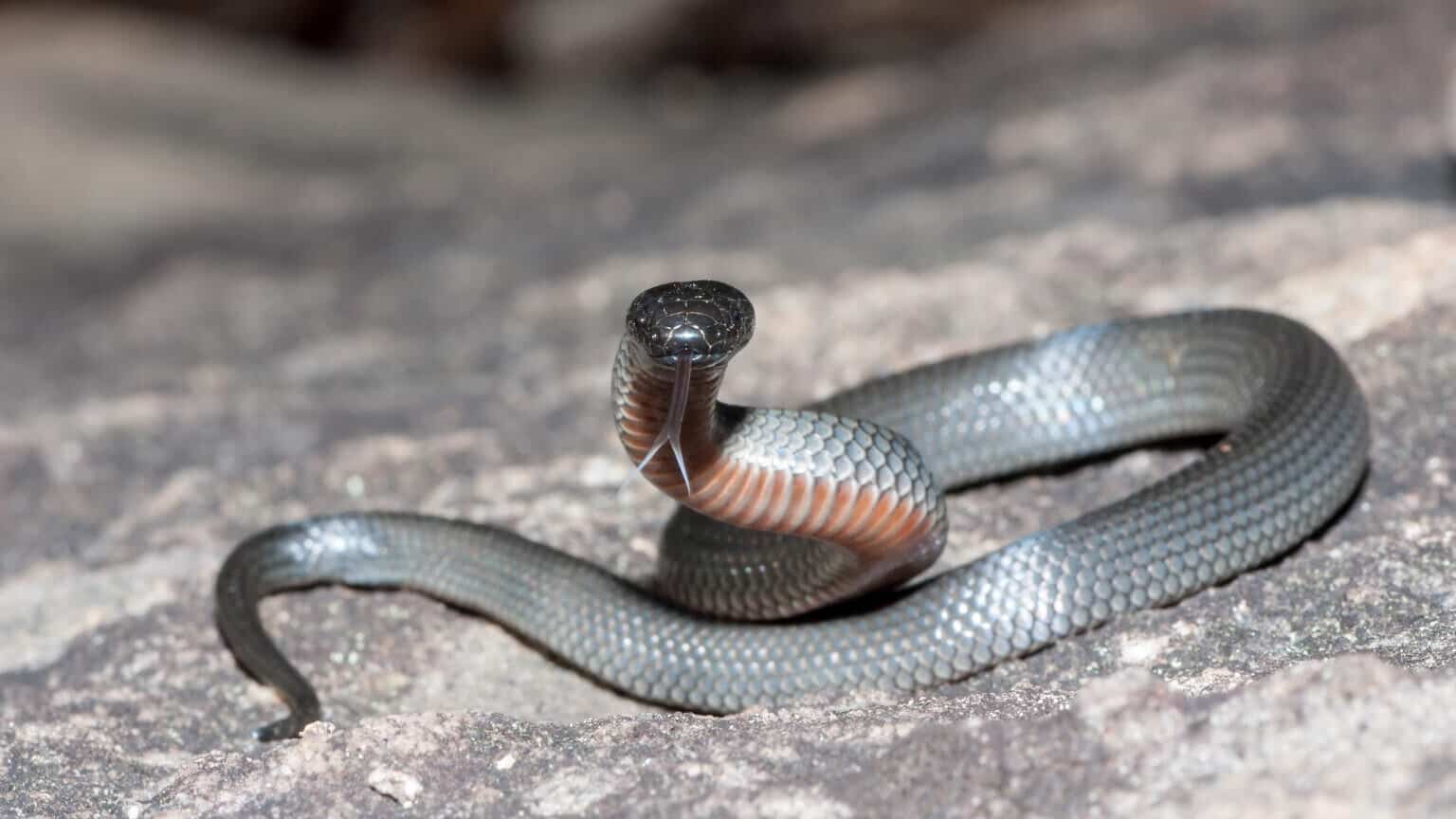
Picture a snake that’s about the length of your favourite ruler, measuring around 50 centimetres on average. These Small-eyed Snakes have, you guessed it, small and unremarkable eyes. But don’t let their unassuming appearance fool you! Their sleek bodies are covered in striking black or dark blue scales that shine like polished gems. And underneath, their bellies are pale cream or pinkish colour. Talk about a fashionable contrast!
Now, if you find yourself exploring the humid and wet rainforests of Australia, keep a keen eye out for these small but intriguing snakes. But here’s a surprise – they also like to hang out near craggy outcrops and wooded areas. And get this, they’ve even been spotted in suburban gardens! These snakes are the ultimate neighbourhood explorers, slithering about in search of their next adventure.
When the sun goes down, and darkness creeps in, that’s when the Small-eyed Snakes spring into action. They become stealthy hunters, targeting geckos, lizards, and even smaller snakes. It’s like they’re having their own nighttime feast! By morning, they retreat to cosy rock crevices and fallen logs, taking a well-deserved break from their nocturnal escapades. And guess what? During winter, dozens of these snakes snuggle up together in tight spaces to stay warm. It’s like a slithery slumber party!
Now, here’s something important to know about the Small-eyed Snake – they’re a shy bunch. Even when they feel disturbed, they prefer not to bite. Instead, they put on quite a dramatic show! They’ll thrash around violently, showing off their wild moves to scare away any potential attackers. It’s their way of saying, “I’m not messing around!” But be warned, their venom is no joke. It’s potent enough to cause kidney failure, so it’s best to look at them from a safe distance and let them continue their secretive snake adventures.
So, my adventurous young explorers, keep your eyes peeled for the Small-eyed Snake’s unassuming gaze. Appreciate their sleek appearance and the wonders of their rainforest and woodland homes. Remember, it’s all part of the incredible tapestry of nature that surrounds us. Stay curious, stay respectful, and keep exploring the wild wonders of the animal kingdom!
Common Death Adder
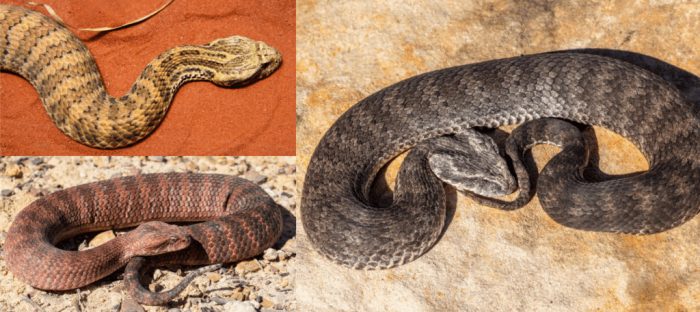
Get ready, young explorers, because we’re about to embark on an exciting journey into the wild world of the Common Death Adder! This incredible snake has some tricks up its scaly sleeve, leaving you amazed and maybe a little cautious. Are you ready to learn all about this master of disguise?
Imagine walking through the eastern parts of Australia, surrounded by rustling leaves and sandy trails. Little do you know, the Common Death Adder lurks under your nose! With its super sneaky camouflage skills, it blends in perfectly with the leaf litter, sand, or gravel. It’s like playing hide-and-seek with a real-life ninja! But wait, there’s more! This clever snake has a secret weapon—a wiggly, worm-like lure at the end of its tail. It wiggles it ever so slightly, like a fisherman with tempting bait, to attract its unsuspecting prey. Talk about a snake with a clever trick!
Now, here’s something fascinating: While other snakes might slither away when they hear you coming, the Common Death Adder has a different strategy. It likes to stay put, even if it means risking being stepped on by someone like you. But don’t worry, it’s not eager to bite unless it’s actually touched. Phew! So, as long as we give it some space and respect its territory, we can all get along just fine.
But, my brave adventurers, there’s something we must remember about the Common Death Adder—it has a venomous bite. Before the invention of special medicine, about half of the people bitten by this snake had a really tough time. Its venom is strong stuff! It contains a special toxin that affects the nervous system, making it hard for the body to move and feel things. That’s why it’s super important to always stay cautious and admire these snakes from a safe distance.
Now, don’t let that scare you, my fearless friends! The animal kingdom is filled with incredible creatures, each with its own unique role to play. By understanding and respecting the Common Death Adder and other amazing animals, we can explore nature’s wonders with joy and curiosity. So, remember to tread carefully, keep your eyes open, and let the spirit of adventure guide you as you learn about the wild and wonderful world around you.
Highlands CopperHeads
Welcome, young nature enthusiasts, to the enchanting world of the Highlands Copperhead, also known as the Pygmy Copperhead! Get ready to explore the cool, mystical forests of Australia, where these incredible snakes slither among the shadows. Are you prepared for an adventure filled with fascinating facts? Let’s dive in!
Picture yourself in a land of towering trees and swirling mists—the high-altitude forests that the Highlands Copperhead calls home. These cunning snakes love to make their cosy hideouts in swampy areas and amidst lush greenery. Keep your eyes peeled near the edges of babbling creeks, beneath ancient fallen trees, and around majestic rocks. That’s where you might catch a glimpse of these elusive creatures.
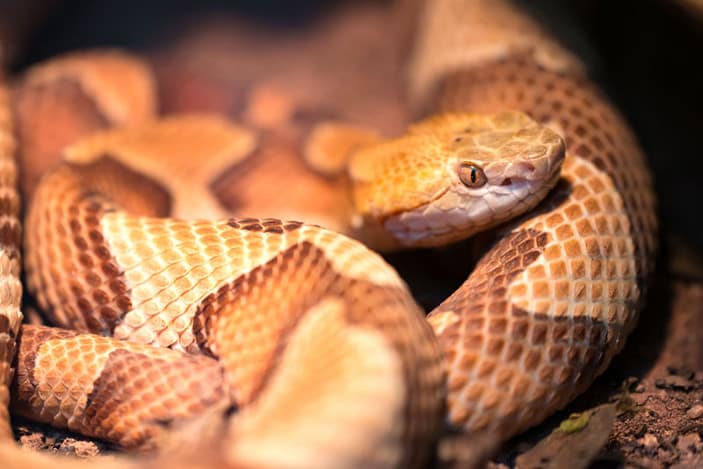
With their muscular bodies and small heads, Highlands Copperheads are like mini warriors of the snake world. They come in different shades of brown or grey, blending perfectly with their surroundings. But here’s a secret—they have a hidden treasure! Lift their bellies, and you’ll find a pale yellow surprise. How cool is that?
When it’s time to fill their bellies, these sneaky snakes have a menu that might make your skin crawl. Frogs and lizards are their usual prey, but guess what? Sometimes they even enjoy a copperhead snack! Yes, you heard it right—they’re not afraid to have a taste of their own kind. But don’t worry, they’re not after humans like us.
Now, prepare for a twist in our story, my young adventurers. Unlike other snakes, Highlands Copperheads can do something extraordinary—they can climb trees! Just imagine these tiny serpents slithering up the trunks, finding the perfect sunny spot to bask and soak up the warmth. It’s like watching nature’s acrobats in action!
Now, here’s the important part, my curious friends. Highlands Copperheads possess venom that can pack quite a punch. Yikes! So, it’s crucial to admire them from a safe distance and let them carry on with their secretive snake business. Remember, they’re not the kind of snakes that seek out human company. If, by some chance, you find yourself face-to-face with a cornered Copperhead, it will let out a loud hiss and put on a flailing show with its flattened body. That’s the snake’s way of saying, “Hey, give me some space!” So, be a respectful explorer and listen to their warnings.
Our journey into the realm of the Highlands Copperhead has come to an end, but the magic of nature will always surround us. As we continue to explore and learn about the wonders of the animal kingdom, let’s always remember to show respect and awe for these incredible creatures.
Red Bellied Black Snake
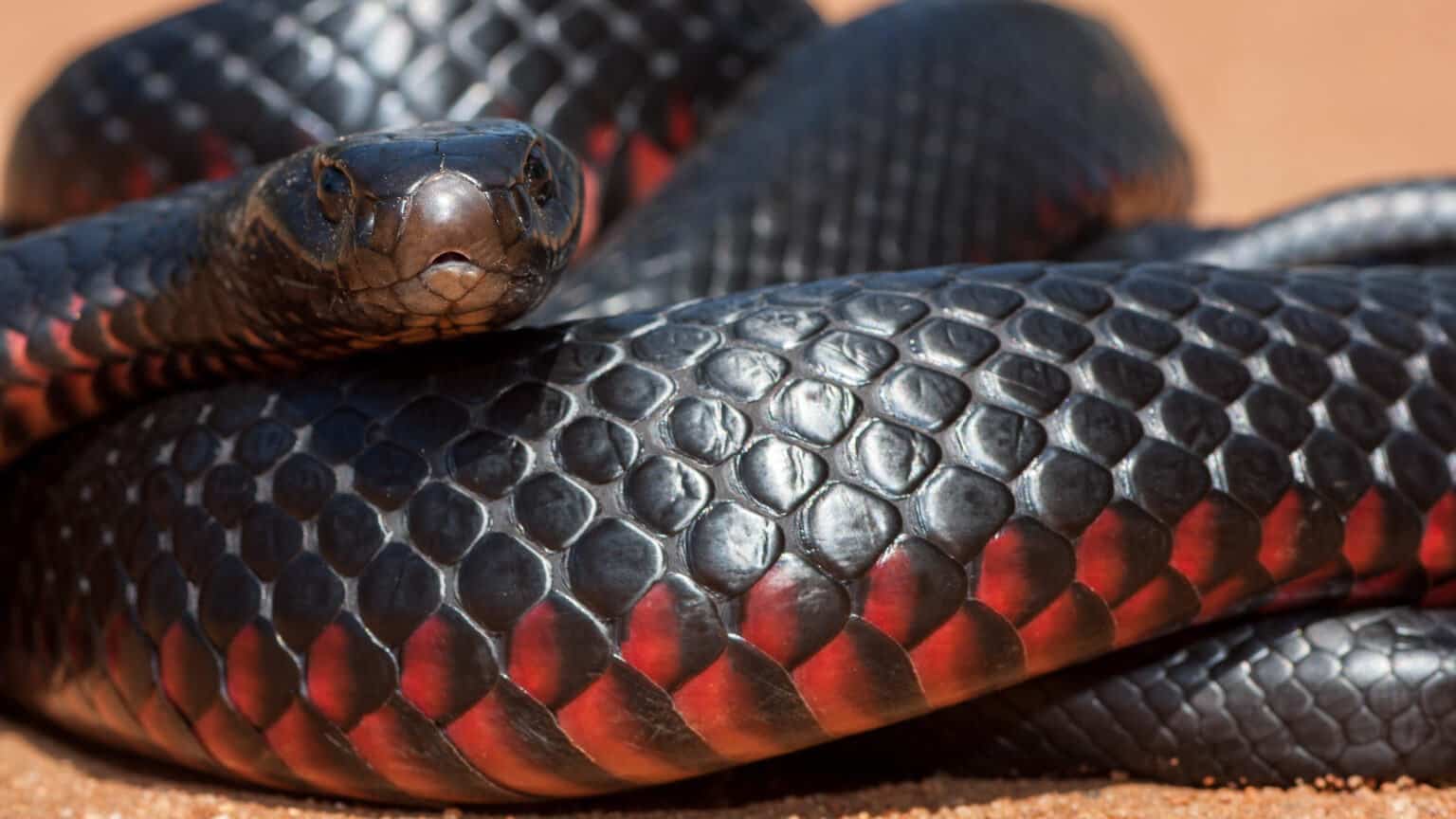
Welcome, curious explorers, to the enchanting world of the Red-bellied Black Snake, also known as the common black snake! Prepare to embark on an exciting journey down the vibrant east coast of Australia near Bondi or Bronte Beach, where these remarkable creatures can be found. You can also get a glimpse of this magnificent creature at Parramatta,Malabar or any other Sydney Suburbs for a wild adventure filled with fascinating facts and intriguing tales!
Picture yourself in this magical land where the Red-bellied Black Snake roams. Although you won’t spot them in Tasmania, they are distributed along the east coast, extending their slithery presence slightly into south-eastern South Australia. But here’s the exciting part—they’re not just dwellers of the wilderness. Oh no! These sneaky serpents have also made their way into urban areas, adding a touch of danger to our everyday lives.
Now, don’t be fooled by their name. The Red-bellied Black Snake isn’t all about the colour red. In fact, their overall appearance showcases a stunning mix of black and red hues. Imagine a sleek and shiny body adorned with a mesmerising touch of red on their bellies. Talk about a fashionable snake, right?
While the Red-bellied Black Snake may be less venomous compared to its venomous counterparts, it’s definitely not one to take lightly. Their bites can cause significant illness and require medical attention. So, it’s important to remember to appreciate these creatures from a safe distance, allowing them to go about their slithery business undisturbed.
In the bustling city of Sydney, the Red-bellied Black Snake has managed to hold its ground as one of the few large venomous snakes still found in the region. These impressive snakes can grow up to a whopping 2 metres long! That’s longer than some humans are tall! And here’s a fun fact—these mighty serpents aren’t afraid to devour other snakes when it comes to mealtime. They’ve got quite the appetite!
Now, let’s talk about their temperament. The Red-bellied Black Snake prefers to avoid human encounters whenever possible. They’re not particularly aggressive and would rather slither away into the distance than engage in a face-to-face meeting. But if they feel threatened, they won’t hesitate to flatten their bodies and unleash a mighty hiss, warning anyone who dares to disturb their peaceful existence.
The venom of the Red-bellied Black Snake may not be lethal, but it packs a punch! When injected into the body, it can cause a blood-clotting disorder and damage muscles and nerves. Imagine feeling a bit wobbly and knocked off your feet! However, confirmed deaths from bites by this species are incredibly rare. Phew, that’s a relief!
As our adventure with the Red-bellied Black Snake comes to an end, remember to always approach nature’s creatures with respect and awe. These magnificent snakes play an important role in maintaining the delicate balance of our ecosystems. By observing them from a safe distance and honouring their space, we can coexist harmoniously with these incredible creatures.
The Gentle Residents: Non-Venomous Snakes of Australia
In the fascinating world of Australian snakes, not all of our slithering friends are venomous. We have a delightful array of non-venomous snakes that coexist peacefully with us humans, earning themselves the title of “friendly neighbours.” These non-venomous snakes play a crucial role in maintaining the delicate balance of nature. From the charming Carpet Python to the captivating Children’s Python, these gentle creatures are a joy to encounter. With their beautiful patterns and graceful movements, they remind us of the wonders of our natural world. So, when you come across these non-venomous snakes during your outdoor adventures, embrace their presence and appreciate the harmony they bring to our shared habitats.
Green Tree Snake
Introducing the Common Tree Snake, a slithery resident of Australia known for its nimble moves and eye-catching appearance! This snake goes by many cool names, like the Australian Tree Snake, Green Tree Snake, Common Bronzeback, and Black Tree Snake. Talk about having an impressive alias!
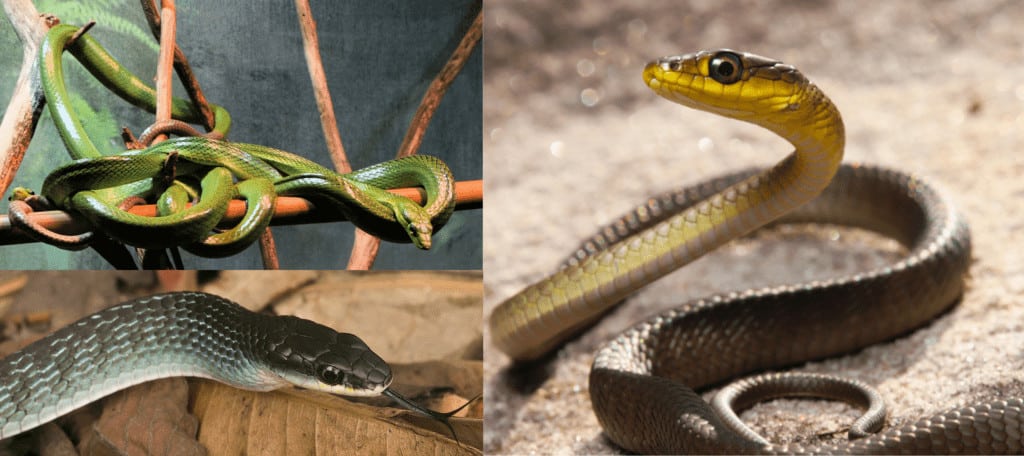
Now, picture a snake that’s like a real-life acrobat, gracefully moving through the trees with its long, whip-like body. The Common Tree Snake can grow up to 170 cm (that’s a whopping 67 inches!) but don’t worry, it’s as slim as can be. And oh, those eyes! They’re huge and round, allowing this snake to see the world with a keen gaze.
When it comes to colours, this snake is a true fashionista. It can be green like the leaves in the forest or rock a cool olive or black outfit. Some even go for a stylish blue look. But wait, there’s more! Check out its throat and belly—pale tan or yellow, like a little touch of sunshine.
Speaking of forests, wetlands, and backyards, that’s where you’ll find our Common Tree Snake. It’s a true Aussie native, calling Australia its home. These snakes love temperate forests and wetlands, and guess what? They might even pop up in your very own suburban backyard. Talk about a slithery surprise!
Now, let’s talk about food. The Common Tree Snake has quite the appetite. It enjoys munching on frogs, small fish, and even water skinks. Yum! It prefers to hang around bodies of water, so you’ll likely find it near ponds, lakes, or streams. These snakes are highly active during the day, hunting for their meals, and when the sun goes down, they cosy up in tree hollows for a good night’s rest. A snake gotta catch some zzz’s, too, you know!
But fear not, young adventurer, because the Common Tree Snake is harmless to humans. It’s a non-venomous snake, meaning its bite won’t hurt you. However, if it feels threatened, it knows how to put on a show. It might puff up its neck, making itself appear bigger and scarier. And watch out—this sneaky snake can release a strong odour that might leave you feeling a bit disoriented. Hold your breath and give it some space!
So, next time you’re out exploring the wilds of Australia, keep an eye out for the marvellous Common Tree Snake. It’s a slender acrobat with a fashionable wardrobe and a love for watery adventures. Just remember, while it may put on a brave face, it’s all for show. This snake is a friendly neighbour, ready to slither away and let you continue your own wild adventure.
Carpet Python
Attention, curious kids! Get ready to explore the enchanting world of the Carpet Python, also known as the Diamond Python. This slithery creature is as fascinating as it sounds!
Imagine a snake that can grow to be a whopping 200-400 cm (that’s a staggering 79-157 inches) long. That’s longer than most of the humans I know! And guess what? Females are even bigger than males. Talk about girl power!
Now, let’s take a closer look at their appearance. These pythons have triangular heads with snouts that are all rounded and cute. They come in a creative array of colours, like olive, yellow, white, brown, and even black. But here’s the fun part—they have blotches, dark borders, or a series of diamonds and patterns on their scales. It’s like having a snake with its own unique fashion statement!
When the sun goes down and night rises high, that’s when the Carpet Python comes out to play. It loves hanging out in trees, making them one of the most common snakes in Australia. You can find them in forests and rocky lowlands, though sometimes they might surprise you by slithering on the ground, soaking up the sun’s warm rays.
Now, let’s talk about food. The Carpet Python has quite the appetite! It enjoys dining on a variety of delicious treats, like rodents, lizards, frogs, and even fledgling birds. But here’s a word of caution—they have been known to snack on small dogs and house cats, so keep your furry friends safe indoors! When it’s time to feast, these pythons use their powerful bodies to coil around their prey, immobilising it before swallowing it whole. And get this—even though they’re not venomous, they have some sharp fangs that they can use as tools. They’re like the Swiss Army knives of the snake world!
Now, don’t worry, my young adventurers. Carpet Pythons are generally harmless to humans. In fact, they’ve become quite famous among exotic pet keepers. But here’s a tip: while they’re usually calm and easygoing, they can still deliver a painful bite with their backward-curving fangs. So, it’s best to appreciate them from a safe distance and leave the snake handling to the experts.
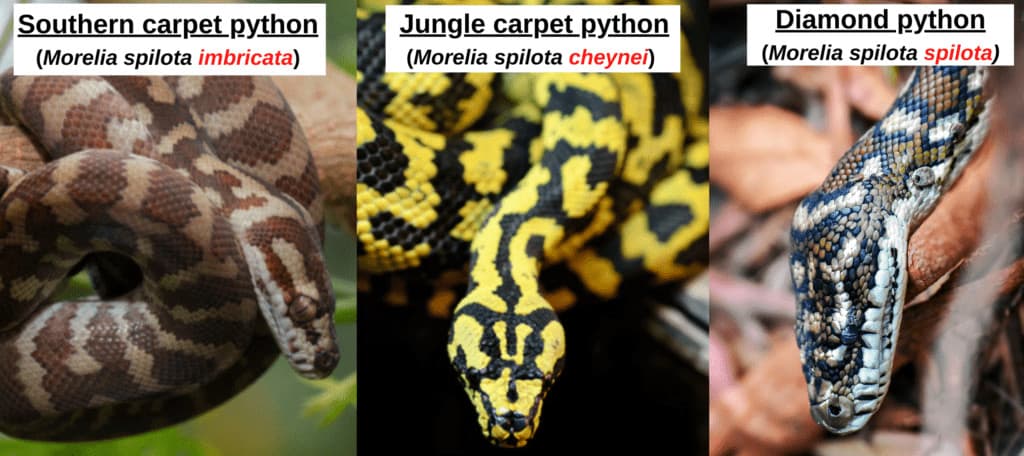
Children’s Python
Hey there, young explorers! Get ready to meet the Children’s Python, a fascinating reptile that’s as cool as can be. This little python goes by many names, like the Banded Rock Python, Gefleckter Python, Stimsons Python, Large-blotched Python, Small-blotched Python, and Eastern Small-blotched Python. Phew, that’s quite a mouthful of names!
Now, picture a snake that’s not too big, not too small—it’s just right! The Children’s Python is the second smallest python in the whole wide world. It measures around 100-150 cm (that’s 39-59 inches) in length. With its light brown colour adorned with dark spots and blotches, it’s like a stylish snake with its own unique pattern. And if you catch it in the sunlight, you might see its skin shimmer with a beautiful rainbow sheen. Talk about being a fashionista!
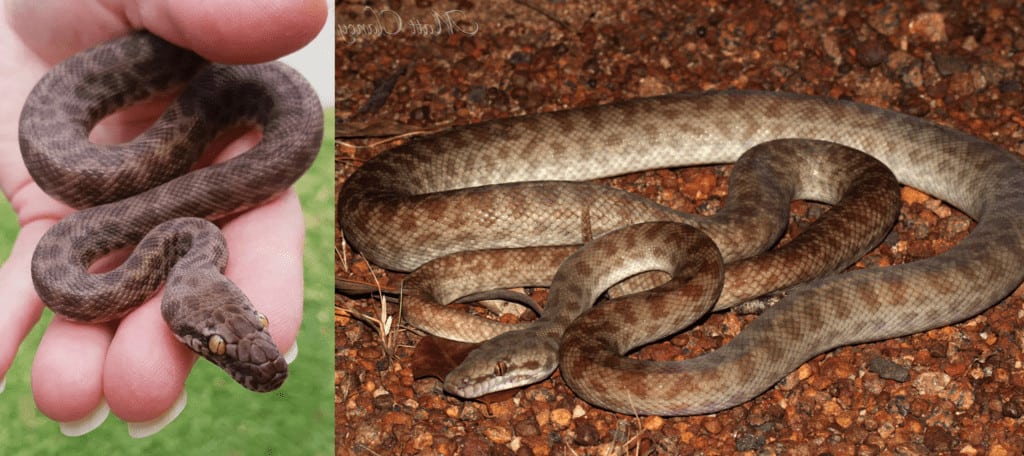
This little python loves hanging out in caves and coastal woodlands. It’s a night owl, preferring to explore when the moon is high in the sky. You might find it lurking in the shadows, ready to pounce on its favourite snacks—birds, and lizards. But don’t be surprised if you spot one soaking up the sun or cozying up inside a hollowed log. Snakes need their chill time too!
Here’s something amazing about the Children’s Python—it’s a skilled acrobat! Imagine this snake hanging upside down from the ceilings of caves, gripping stalactites like a true daredevil. And guess what it’s after? Bats! Yep, it’s like a snakey superhero, snatching bats right out of the air. With lightning-fast reflexes, it catches them mid-flight and gives them a tight squeeze before swallowing them whole. Talk about a jaw-dropping trick!
Now, listen up, my fellow nature enthusiasts. While Children’s Pythons may seem like cool pets, it’s important to remember that they’re best left in their natural habitat. Taking them from their home in Australia can disrupt their ecosystem. So, let’s admire these incredible pythons in the wild and observe their natural behaviour from a respectful distance.
So, there you have it, my adventurous friends—the amazing Children’s Python! It’s a small but mighty snake with a style all its own. With its unique patterns, acrobatic skills, and taste for bats, it’s a creature worth admiring. So, keep your eyes open for your next Australian escapade—you never know when you might spot this captivating python in action. Happy exploring!
Black Headed Python
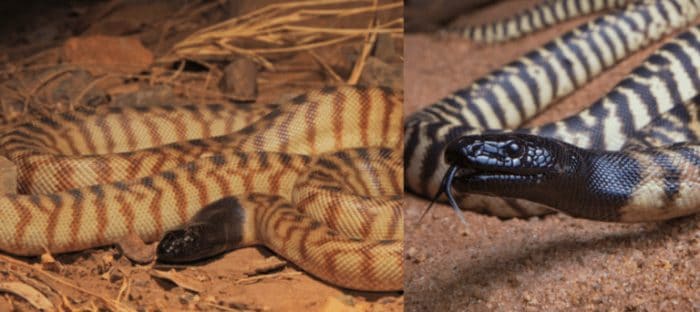
Gather ’round, young explorers, because we’re about to dive into the world of the magnificent Black-headed Python! This slithery wonder goes by many names, like the Rock Python, Tar Pot Snake, and Terry Tar Pot. Talk about having an impressive collection of aliases!
Now, picture a snake that can grow to be around 150-200 cm (that’s a whopping 59-79 inches) long. That’s like having a living measuring tape right in front of you! These pythons have muscular bodies that taper towards their tails, making them quite the elegant slitherers. But here’s what really sets them apart—their heads and necks are as black as midnight, as if they dipped their heads head-first into a pot of ink. Quite the striking fashion statement, don’t you think?
If you’re out exploring the wilds of northern Australia, keep your eyes peeled for these fascinating creatures. Black-headed Pythons like to call semiarid regions and coastal forests their home. But here’s a fun fact—they’re night owls! During the day, you’ll find them resting in crevasses and cosy spots within dead wood. It’s like having their own secret hideout from those pesky predatory birds.
Now, let’s talk about food, because these pythons have quite the adventurous palate. They enjoy dining on other reptiles, and get this—they’ve even been known to cannibalise their own species. Talk about having a taste for the unconventional! But here’s the real kicker—given the chance, they’ll even snack on highly venomous snakes. It’s like being a superhero in the snake world! Now, if you happen to stumble upon one of these pythons and get a little too close for comfort, don’t be alarmed if you hear a loud hiss. It’s their way of warning you to keep your distance. But fear not, my young friends, because these pythons are non-venomous and completely harmless to us humans.
Now, here’s a cool tidbit about these pythons. You know how dark colours are great at absorbing heat? Well, Black-headed Pythons have figured out how to use this to their advantage. As the sun begins to rise, they poke out their ink-black heads, just like little solar panels, to soak in those warm rays. The heated blood then travels through their bodies, keeping them nice and toasty without having to leave their burrows. It’s like having their own built-in heating system!
So there you have it—the remarkable Black-headed Python, with its striking black head, impressive hunting skills, and clever use of solar power. Keep your eyes open and your sense of wonder alive as you explore the wilds of Australia. Who knows what other marvellous creatures you’ll encounter along the way? Happy snake spotting, my adventurous friends!
Bandy Bandy Snake
Hey there, curious adventurers! Let me introduce you to a fascinating little snake called the Bandy Bandy. It’s also known as the Hoop Snake and Eastern Bandy-Bandy. How cool are those names?
Now, close your eyes and imagine a snake that fits exactly in the palm of your hand. The Bandy Bandy is just that! It’s a petite snake, measuring around 50-60 cm (about 20-24 inches) in length. It has a small head and a cute blunt-tipped tail. But what really makes it creative is its fancy fashion sense. The Bandy Bandy sports a striking black-and-white striped pattern along its body. Talk about being a trendsetter in the snake world!
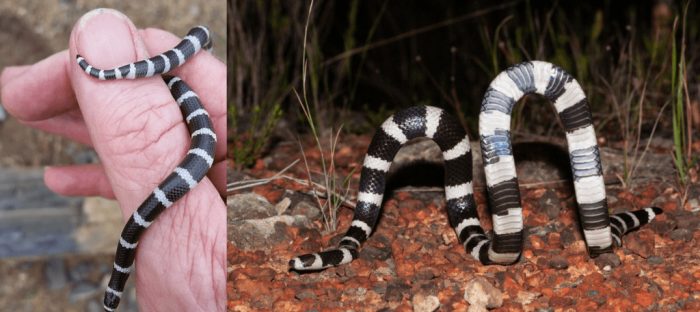
This adorable snake is a true Aussie native, found all across Australia. It’s a real explorer, venturing into dense forests, arid regions with little vegetation, and even woodlands near suburbs. You might spot them when the air is thick with humidity or after a refreshing rain shower. They love those damp evenings!
Now, let me share a secret about Bandy Bandy’s menu. This snake has a very specific taste—it exclusively dines on blind snakes. Isn’t that fascinating? And here’s a funny sight: sometimes you might catch a glimpse of a Bandy Bandy with its meal sticking out of its mouth, like a little snakey snake. After a hearty feast, this snake can go for months without eating again. Talk about having a full belly!
But wait, there’s more to this slithery creature. When the Bandy Bandy feels threatened, it has a clever trick up its sleeve. Well, not really sleeves because snakes don’t have arms, but you get the idea! It raises its body off the ground in loops. It’s like doing a fancy snake dance move! Scientists aren’t sure why exactly they do this, but they think it might confuse predators, like wise owls who might be thinking, “Wait, what’s going on here?”
So, my young friends, keep your eyes peeled for the marvellous Bandy Bandy on your Australian adventures. It’s a small snake with a big personality, rocking its black and white stripes with style. Remember, they’re harmless and just minding their own snakey business. So, if you ever come across one, give it a nod and let it continue its slithery escapades. Happy exploring!
Blind Snake

Listen up, curious explorers, because we’re about to uncover the secrets of the incredible Prong-snouted Blind Snake! This unique serpent may be small, measuring around 30-45 cm (that’s 12-18 inches) in length, but it’s definitely not one to be underestimated.
Now, picture a snake with a head that seamlessly blends into its body and tiny pin-prick eyes accompanied by drooping snouts. It’s like a master of disguise, and if you’re not paying close attention, you will mistake it for an earthworm! These snakes have a shiny brown colour that makes them quite inconspicuous.
Finding the elusive Prong-snouted Blind Snake in Australia is no easy task. They’re true masters of hiding, and their range remains a bit of a mystery. But they are found to thrive in various habitats, from grasslands to coastal regions. They’re like secret agents, blending in wherever they go!
Now, here’s where it gets interesting. Prong-snouted Blind Snakes are expert burrowers, spending most of their lives underground. But on warm, humid nights, they emerge from their hidden abodes and make their way to ant tunnels and termite mounds. Why, you ask? Well, it’s dinner time! These clever snakes patiently wait for a group of insects to return to their home, and then they strike, picking off their prey one by one. Talk about a sneaky feast!
Here’s a fun fact to remember: Prong-snouted Blind Snakes aren’t capable of biting. Nope, not at all! They’re completely harmless to humans and don’t have any venom to speak of. However, it’s always wise to give them their space and not poke or prod them. You see, they have a few defence mechanisms up their sleeve. They can expel a bad odour from their anal glands, kind of like releasing a stinky bomb! And if that’s not enough to deter intruders, they can also use their spined tails to give a prickly surprise. Ouch!
Common Keelbacks
Listen up, my friends, because we’re about to dive into the world of the Common Keelback—a snake that may look like it’s dangerous cousins but is actually as harmless as can be. You might also hear it called Mair’s Keelback, which adds a flair of mystery to this fascinating creature.
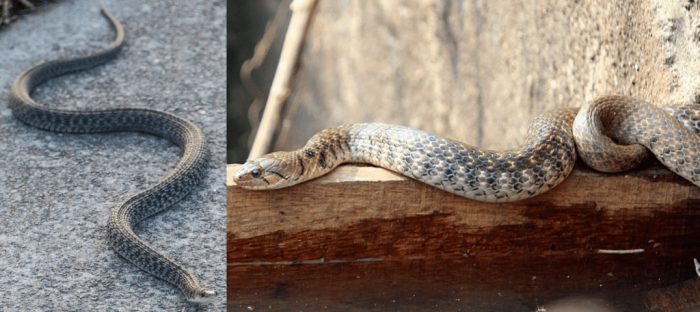
Now, picture a snake that’s not too big, not too small—just the right size, measuring around 50-75 cm (that’s 20-30 inches) in length. Its body can be grey, brown, or olive, blending in perfectly with its surroundings. And check out its cream-coloured undersides—it’s like wearing a warm sweater on the inside!
If you happen to find yourself near creeks and floodplains in Australia, keep an eye out for the Common Keelback. These slithering beauties might glide through the water, showing off their amazing swimming skills. But don’t get too close! If you try to approach, they’ll make a speedy getaway into burrows or hide among waterlogged plants. Safety first, you know!
Now, here’s something cool about the Common Keelback—it’s a master of adaptation. Depending on the temperatures outside, it can be active during the day or become a night owl. It knows how to go with the flow! And those keeled scales on its body? They’re like built-in grip shoes, helping it glide across slippery surfaces in the wild. Talk about being prepared for any situation!
But wait, there’s more! The Common Keelback has a secret weapon—its sharp, angled teeth. These teeth come in handy when it’s time for a meal. Its diet includes all sorts of tasty treats like amphibians, fish, and lizards. But here’s the really interesting part: it’s one of the few animals that can actually eat poisonous Cane Toads! They must have some sort of superpower to handle those toxins. Go, Common Keelback!
So, my fellow adventurers, remember that appearances can be deceiving. The Common Keelback might resemble some dangerous snakes, but it’s harmless to humans. It’s a true survivor, equipped with adaptations for different times of day, slippery surfaces, and even toxic prey. So, keep your eyes wide open and your curiosity alive—you never know when you might spot this incredible snake on your next Australian adventure. Stay wild!
Snake Safety: Tips for Encountering Snakes
Wondering what to do if you come face to face with these slithering creatures? No worries, if you ever come across a slithery surprise on your property, remember these important tips to stay safe and keep the snake happy too.
First things first, never ever try to catch or harm a snake. They’re not big fans of that and might defend themselves if they feel threatened. Yikes! We want to avoid that, right? Most snake bites usually happen when people try to intentionally mess with them, and we definitely don’t want that to happen.
If you spot a snake outside in your yard, it’s best to go inside the house with your friends or siblings. We want to keep everyone, especially kids, at a safe distance. Snakes are not playmates, after all. And don’t forget about our furry friends! Keep your dogs and cats away too. You can even shower them with the hose to keep their curious noses away from the snake.
Now, if you want the snake to find a new home, it’s time to call in the experts. Yep, that’s where licensed snake catchers come in. They’re like snake superheroes! They know all about handling snakes and can safely remove them from your property. Keep a careful eye on the snake from a safe distance until your beloved rescuer-the snake catcher, arrives. That way, they can find and help the snake find a new place to slither.
To find a snake catcher, you can check out the “Catch That Snake” website.They provide snake catching service around Brisbane, Goldcoast, Logan and Ipswich.
For anyone from New South Wales you can check out this Reptile Handler List made by the government about all their snake handlers who can legally operate anywhere in NSW. Similarly, the Northern Territory Government has also got its own “Report A Snake” system which helps its citizens to catch any unauthorised entry by the reptile.If you are from South Australia and you see a snake in your home then your best bet is to call “Snake Handler” from the local government’s list of snake handlers services at your local area.If you are from Tasmania then you are lucky as they too have “Reptile Rescue” who have doing snake rescues from very long time and can solve your snake problem.
But remember, snake catchers usually charge a fee for their service. They’re amazing at what they do, so showing them some appreciation for their time and effort is important.
Now, let’s discuss finding a snake inside your house or another building. If it happens, stay calm! We don’t want to startle the snake and make things chaotic. Never, ever try to catch or harm the snake. Remember, most snake bites happen when people try to mess with them. Let’s keep things peaceful and let the experts handle it.
So there you have it! Remember to give snakes their space, call a snake catcher if needed, and always be calm and kind. Snakes are fascinating creatures, and with a little knowledge and respect, we can coexist together in this wild and wonderful world.
Reptile Wonders: Must-Visit Places to See Snakes
Are you ready for a thrilling snake encounter? Hold on tight as we explore some amazing wildlife parks and reptile houses where you can see these fascinating creatures up close!
Caversham Wildlife Park
Want to see snakes in real life?
Prepare to start on an incredible journey to Caversham Wildlife Park, located just a quick 25-minute drive from Perth. Brace yourselves because this place is a treasure trove of thrilling encounters, including a chance to meet some slithering superstars—snakes!
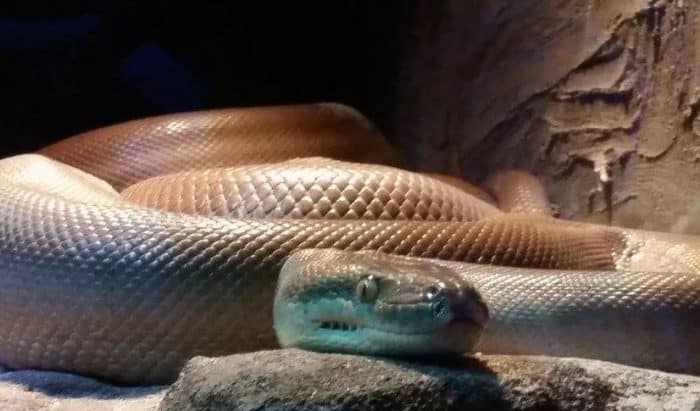
But wait, there’s more! As you step foot into the park, get ready to mingle with kangaroos, marvel at magnificent birds, and even have a face-to-face with cute and cuddly wombats. And when it’s time to get up close and personal with snakes, the friendly staff will guide you as you hold these fascinating creatures and strike a pose for an unforgettable photo. But that’s not all—don’t miss out on the penguins, the action-packed Farm Show, and the opportunity to pet a koala.
With interactive shows, feeding experiences, and incredible wildlife encounters all included in your visit, Caversham Wildlife Park is the place where the adventure begins! So gather your courage, bring your sense of wonder, and let’s embark on a wild and snake-tactic expedition you’ll never forget!
Australian Reptile Park
Love Snakes? Want to know more about them? Then, pack your sense of an epic adventure and visit Australian Reptile Park, nestled in the picturesque Central Coast of New South Wales, just a scenic 60-minute drive from Sydney or Newcastle. This remarkable park is not your ordinary zoo—it’s Australia’s original hands-on zoo!

Prepare to be amazed as you wander through a natural bush setting and encounter over 2,000 incredible animals. Get up close and personal with cuddly koalas, friendly kangaroos, adorable quokkas, and majestic dingoes. But hold onto your hats because here comes the thrilling part—brace yourself to meet some of the most massive pythons you’ve ever seen! Test your bravery and feel the thrill as you hold these incredible snakes and capture the memory with a photo that will leave your friends in awe. As you explore, you’ll also learn about the Australian Reptile Park’s vital work in the antivenom program, saving lives and protecting Australia’s unique wildlife.
Fun Facts About Snakes
Did you know that snakes are some of the coolest creatures on our planet? Let’s dive into the marvellous world of snakes and discover some fascinating facts that will make you go, “Wow!”
Fact #1: There are over 3,700 snake species out there! That’s a lot of slithering friends. And guess what? Scientists are still finding new snake species all the time. Just last year, they discovered a bright and beautiful snake called Phalotris shawnella in Paraguay. Isn’t that amazing?
Fact #2: Snakes have been around for a long time. They evolved around 98 to 142 million years ago during the time of dinosaurs. Can you believe it? They’re younger than other reptiles like crocodiles and turtles. Talk about being fashionably late to the reptile party!
Fact #3: Snakes can live in the sea too! While most snakes prefer the land, about 70 sneaky snakes make their homes in the Indian and Pacific Oceans. They’re called sea snakes and are fully adapted to life underwater. They’re like the scuba divers of the snake world, exploring the ocean depths.
Fact #4: Snakes are like solar-powered machines. They’re not actually “cold-blooded,” as people say. Their blood gets its warmth from the sun and other external sources. It’s like they’re soaking up the sunshine to keep their bodies cosy. How cool is that?
Fact #5: Snakes have a super sense of smell. Instead of using their noses, they flick out their tongues to pick up scents. And guess what? They have an amazing organ called the Jacobson’s organ on the top of their mouth that helps them detect smells. It’s like having a built-in scent detector!
Fact #6: Snakes are real superheroes of the ecosystem. They play a crucial role in keeping the balance of nature. As predators, they help the world to control the population of small animals like rodents, birds, and insects. Without them, things would get out of control! They’re like nature’s very own pest control team.
Snakes may have a bad rap sometimes, but they’re incredible creatures that deserve our respect. They’ve adapted to almost every corner of our planet, and they’ve been around for ages, even without legs! So let’s celebrate the facts of snake behaviour and remember that these slithery friends are essential to the health of our planet.
Prevalent Myths and Misconceptions about Snakes
Throughout history, there have been many fascinating myths and legends surrounding snakes. Let’s explore some of these stories and separate fact from fiction.
One myth suggests that a bowl of milk can attract snakes. This belief came from the Milk Snake, which was mistakenly thought to drink milk from cows’ udders. However, snakes cannot digest dairy, and cows aren’t keen on sharing their milk either. Snakes will drink anything when they’re really thirsty, but milk isn’t their preferred beverage.
Another tale involves Blue-tongue Lizards and Shinglebacks as garden protectors keeping snakes away. While these lizards are heroes in their own right, snakes are skilled hunters and can prey on frogs, lizards, and even other snakes. So, while young snakes may be at risk, as they grow, they become the rulers of the garden.
One of the most creepy myths suggests that a snake can survive after its head is cut off until sundown. Thankfully, this is not true. When a snake loses its head, it’s game over. The body’s movements after decapitation are simply involuntary reactions, not a supernatural survival ability.
Some people used to believe that a mother snake would eat her own young to protect them. However, this is not how snakes behave. If a snake accidentally swallows another snake, it becomes a meal, not an act of maternal protection.
There is a common misconception that snakes always travel in pairs. In reality, snakes are solitary creatures, going about their slithery business independently. The only time you might see two snakes together is during courtship and mating, and even then, it’s not a buddy comedy but a serious affair.
A spooky bollywood myth warns that if you kill a snake, its partner will seek revenge. But fear not, for snakes don’t hold grudges or recognize their attackers. If you ever see a snake, give it space, and it will go on its way without any ill intentions.
And what about the legendary Hoop Snake that rolls down hills? Well, that’s purely fictional, like a creature from a fantasy book. But the symbolism of a snake devouring its own tail, like the ouroboros, represents endless renewal and is fascinating to ponder.
Now, let’s debunk a few misconceptions. Snakes are not cold and slimy; their skin is dry and can feel warm and soft. Snakes are also not out to get you. They prefer to avoid humans, as we are much larger, faster, and stronger than they are. Most snake encounters occur when they are caught off guard and are just as eager to escape as we are to avoid them.
It’s important to note that snakes are venomous, not poisonous. Venom is injected into the bloodstream, while poison is ingested or absorbed through the skin. Not all snakes are venomous, and they won’t harm you unless they feel threatened.
One fascinating fact about snakes is that while they may not hear like we do, they have inner ears that can detect ground vibrations and low-frequency sounds. They are more attuned to their surroundings than we might think.
Lastly, let’s demystify snake feeding. Snakes do not dislocate their jaws; they have highly flexible ligaments that allow their mouths to stretch wide open. When pythons constrict their prey, they are cutting off blood circulation, not suffocating them by squeezing the air out.
So, while snakes have inspired captivating myths and legends, it’s important to separate fact from fiction. Snakes are remarkable creatures that play vital roles in our ecosystems. Let’s appreciate them for their beauty and unique characteristics, and let their enchanting tales spark our imaginations.
Stay Snake Smart and Safe!
So, my courageous young explorers, as we conclude our journey into the fascinating world of snakes, let us remember to be snake smart and safe. With knowledge, respect, and a dash of caution, we can better understand these remarkable creatures and coexist harmoniously with them in the wild. Happy exploring, and stay curious!
For more holiday ideas – click here.
Happy Exploring!



